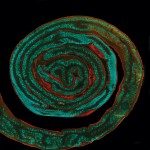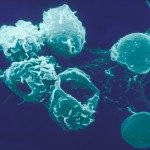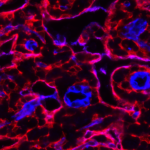Lien vers Pubmed [PMID] – 19164539
Proc. Natl. Acad. Sci. U.S.A. 2009 Feb;106(5):1512-7
The thymus represents the “cradle” for T cell development, with thymic stroma providing multiple soluble and membrane cues to developing thymocytes. Although IL-7 is recognized as an essential factor for thymopoiesis, the “environmental niche” of thymic IL-7 activity remains poorly characterized in vivo. Using bacterial artificial chromosome transgenic mice in which YFP is under control of IL-7 promoter, we identify a subset of thymic epithelial cells (TECs) that co-express YFP and high levels of Il7 transcripts (IL-7(hi) cells). IL-7(hi) TECs arise during early fetal development, persist throughout life, and co-express homeostatic chemokines (Ccl19, Ccl25, Cxcl12) and cytokines (Il15) that are critical for normal thymopoiesis. In the adult thymus, IL-7(hi) cells localize to the cortico-medullary junction and display traits of both cortical and medullary TECs. Interestingly, the frequency of IL-7(hi) cells decreases with age, suggesting a mechanism for the age-related thymic involution that is associated with declining IL-7 levels. Our temporal-spatial analysis of IL-7-producing cells in the thymus in vivo suggests that thymic IL-7 levels are dynamically regulated under distinct physiological conditions. This IL-7 reporter mouse provides a valuable tool to further dissect the mechanisms that govern thymic IL-7 expression in vivo.




